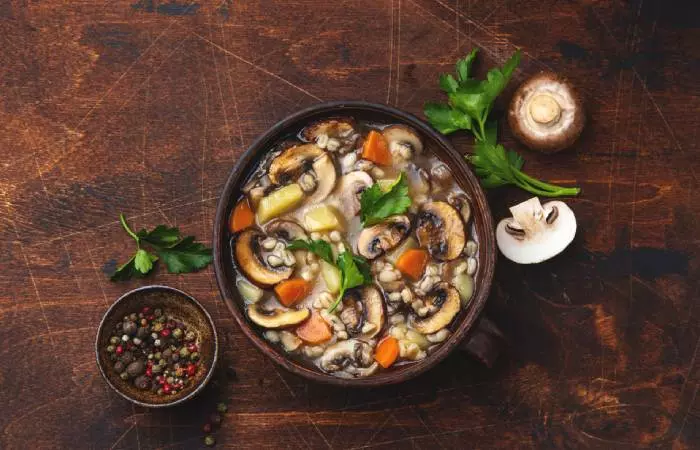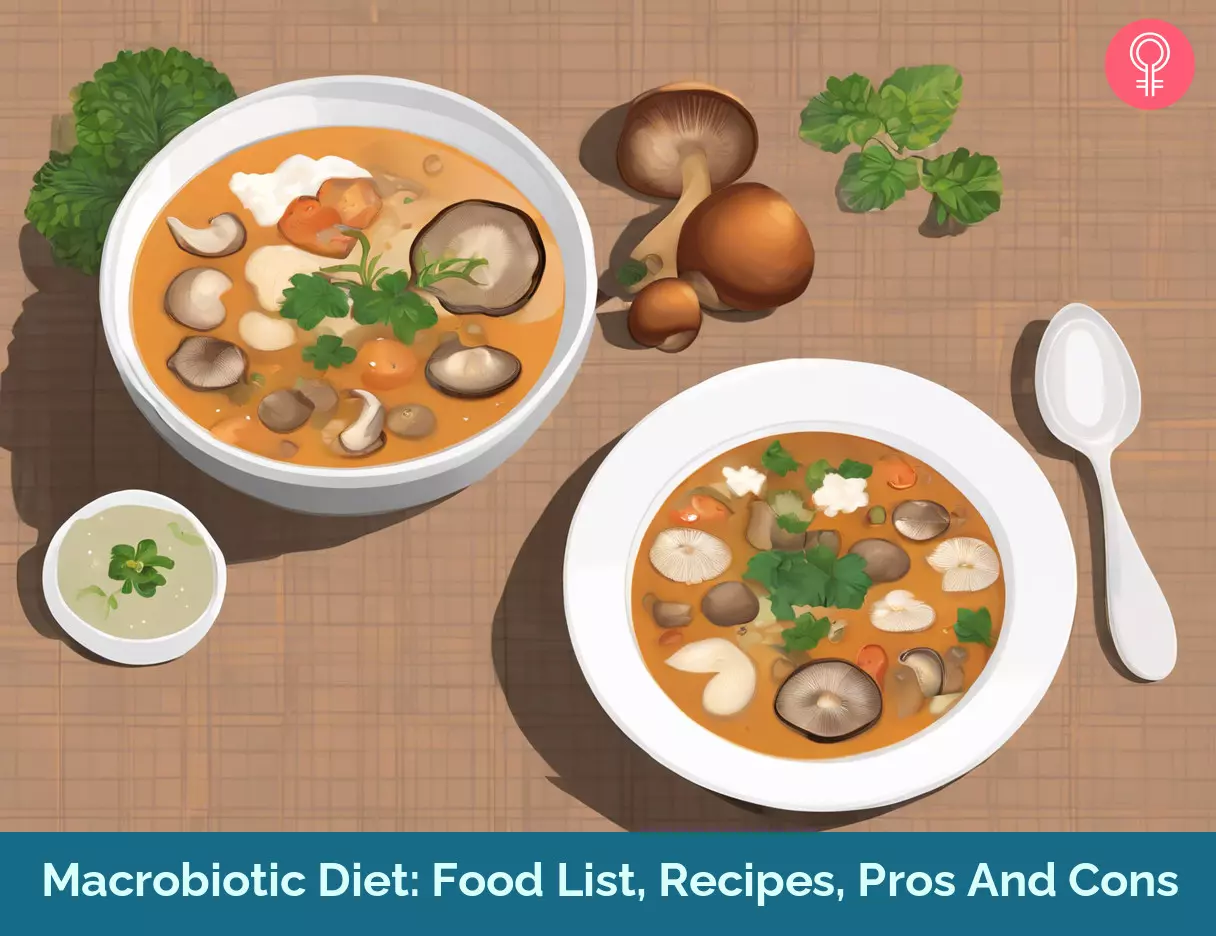What Is The Macrobiotic Diet?
The name of the diet is derived from the Greek terms “macro” for “great” and “bios” for “life.” The macrobiotic diet is a dietary approach that focuses on balance and harmony in life. It originated in the 1920s from the ideas of George Ohsawa, a Japanese philosopher. This diet focuses on the intake of whole grains, vegetables, fruits, beans, seeds, nuts, and miso soup, and abstains from refined and processed foods, sugar, and a majority of animal products. Similarly, the MIND diet integrates aspects of the macrobiotic approach, focussing on brain health, combining elements from Mediterranean and DASH diets. People who follow this diet also try to live a chemical-free and holistic lifestyle. They avoid dietary additives, pesticides, and even exposure to electromagnetic radiation. The diet also promotes regular exercise, the use of natural ingredients in cooking, and refrains the consumption of nutritional supplements. While there is limited research on this diet, many proponents report feeling better and more balanced after following it. An individual’s health, age, gender, and region may determine what foods to include in their diet. The macrobiotic diet promotes a natural and mindful way of life. But how does it improve your overall health and well-being? Learn more in the next section.
Health Benefits Of The Macrobiotic Diet
1. May Reduce Inflammation
The percentage of fiber-rich foods in the macrobiotic diet is far greater than that of the typical American diet (1). The high fiber may help reduce inflammation and the risk of obesity (2). Another study suggests that fiber could help reduce inflammation in the body through its interaction with the gut microbiota. When people eat more fiber, their gut bacteria change in a way that can reduce inflammation(3).
2. May Boost Heart Health
The high-fiber foods in the macrobiotic diet may help reduce cholesterol levels and regulate blood pressure levels. This can promote overall heart health (4). As per another study, eating soluble fibers and fiber-rich foods has various health benefits, including lowering cholesterol, reducing blood pressure, managing blood sugar, aiding weight loss, boosting the immune system, and decreasing inflammation (5).
3. May Reduce Cancer Risk
The intake of vegetables may help reduce cancer risk. The antioxidantsi Compounds present in fruits and vegetables that combat free radicals and reduce the risk of diseases like cancer. and phytoestrogensi Compounds found in soy and legumes that may mimic the estrogen in the body and potentially influence hormone-related health issues. in veggies may help control estrogen levels in women over 50, lowering the risk of breast cancer (6). As per another study, high-fiber intake might reduce the risk of cancers including Oral and Pharynx, esophageal, stomach, and colorectal cancer (7).
4. May Help Regulate Diabetes
Regular consumption of whole grains, fruits, and vegetables in this diet may boost insulin sensitivityi The cells’ ability to effectively respond to insulin to take glucose and regulate blood sugar levels in the body. and reduce body weight. This can help keep your diabetes in check (8). However, further studies are needed to confirm its long-term effectiveness. A study on the Ma-Pi 2 macrobiotic diet showed improvements in blood sugar, cholesterol, and insulin in type 2 diabetes patients, likely due to a positive effect on gut bacteria. Adding prebiotics to your diet, like fiber, can help reduce inflammation, improve insulin sensitivity, and enhance glucose control (9).
5. May Help Maintain Healthy Calorie Balance
The macrobiotic diet restricts sugar and processed foods intake and encourages the consumption of nutrient-rich foods. This may help you in maintaining a healthy calorie balance while getting essential vitamins and minerals. Additionally, the Japanese diet reflects some aspects of the macrobiotic diet, emphasizing balanced eating through traditional practices.
6. Improves Overall Health
Maintaining a healthy calorie balance through the macrobiotic diet can have beneficial consequences. By limiting sugar and processed foods while emphasizing nutrient-rich options, you may achieve weight management and overall well-being. For a holistic approach, the Ayurvedic diet complements the macrobiotic diet by aligning food choices with your body’s unique needs and energies.
7. May Aid In Weight Management
A study found that following a macrobiotic diet may reduce overall body weight, cholesterol levels, and oxidative stress (1). The diet encourages mindful eating habits like eating slowly, enjoying your meals, and being aware of how your body feels. These practices can help control your food intake. They also enable a healthier relationship with food and reduce the chances of emotional eating. The macrobiotic diet focuses on the intake of nutritious food options for long-term health. This diet is closely aligned with the principles of the Blue Zone diet, which focuses on eating like people from regions known for their longevity. We have elaborated on those options in the section below. Take a look.
Foods To Eat On The Macrobiotic Diet
The macrobiotic diet revolves around whole grains, seaweed, beans and soy, and certain organic vegetables. The foods you can eat on this diet include:
1. Whole Grains
Whole, organic grains are the cornerstone of the macrobiotic diet. This group accounts for 50% of your daily food intake. It includes:
Brown rice Barley Oats Corn Rye Wheat Buckwheat
Whole cereal grains are favored over processed grain products like bread and pasta.
2. Vegetables And Seaweed
This group accounts for 25-33% of your daily food intake. It includes the following vegetables:
Kale Cauliflower Broccoli Pumpkin Bok choy Onion Radishes Carrots Parsley Green cabbage
It also includes the following types of seaweed:
Agar-agar Arame Nori Irish moss Kelp Dulse Kombu Wakame
3. Pulses
This group accounts for 5-10% of your daily diet. It includes:
Lentils Adzuki beans Chickpeas Tofu Tempeh Soybeans and fermented soy products
4. Miscellaneous Foods
The remaining 5-10% of your daily food intake may include:
Fruits (in moderation) Whitefish (occasionally) Seeds (lightly roasted and salted, in limited quantities) Nuts (sparingly) Miso soup
The protein in the diet primarily comes from beans and soy products like tofu, tempeh, and miso. You may also include fresh seafood or fish once a while.
6. Oils
Cooking oils include:
Light or dark sesame oil Unrefined vegetable oil Corn oil Mustard seed oil
You can also consume fermented pickles, grated ginger, soy sauce, and umeboshi vinegars and plums. While including these important foods is one part of the equation, avoiding a few other foods is another. We have listed certain forbidden foods in the next section. Take a look.
Foods To Avoid On The Macrobiotic Diet
Dairy products like milk, cheese, yogurt, and butter High-mercury seafood like tuna, shark, and swordfish Tropical fruits like pineapple and mangoes Nightshade vegetables like tomatoes, eggplants, potatoes, and bell peppers Highly processed foods such as sugary snacks, fast food, packaged convenience meals, and refined grains. Meat and poultry products Refined sugar Alcohol Coffee Caffeinated beverages Soda Chocolate and cocoa products Hot and spicy foods
You can drink water and specific beverages like dandelion root tea or cereal grain coffee to quench your thirst. However, do not use these beverages to skip or replace your meals. The list of forbidden foods may make the macrobiotic diet appear restrictive. But that is not the case. You can make a variety of delicious yet nutrient-dense dishes with the available options. Learn more in the next section.
Macrobiotic Diet Recipes
Mushroom Barley Soup
Ingredients
3 tablespoons of olive oil/untoasted sesame oil 1/4 oz. of dried shiitake mushrooms (soaked in 1 cup of hot water) 5 pounds of cremini and shiitake mushrooms, sliced 1/4 cup of chopped shallots 1 small chopped onion 1 diced celery stalk 1 diced carrot 1/2 cup of pearled barley 4 cups of vegetable stock (or water) 4 tablespoons of tamari (a type of soy sauce) 1 sprig of fresh thyme 1 bay leaf Sea salt and black pepper (to taste) 5 sprigs of fresh dill (to garnish)
How To Prepare
Macrobiotic Pressed Salad
Ingredients
1 head of napa or green cabbage (sliced thinly) 1 cucumber (sliced in half lengthwise, de-seeded, and thinly sliced) 1 small daikon radish (grated) or 6 red radishes (thinly sliced) 2 stalks of celery (thinly sliced diagonally) 1/2 of medium red onion (sliced very thinly) 2 medium carrots (grated) 1 teaspoon of sea salt 1/4 cup of brown rice vinegar or umeboshi plum vinegar
How To Prepare These dishes are nutritious, wholesome, and healthy. Does this mean that anyone can follow this diet? Probably not, as the diet also poses certain risks to some people. Learn more in the next section.
Risks And Side Effects Of The Macrobiotic Diet
May Cause Nutritional Deficiencies
The exclusion of various animal products may cause protein, calcium, iron, and vitamins B1 and B12 deficiencies in some people. These deficiencies may lead to lower bone density and increase anemia risk among other issues (10), (11), (12).
May Cause Unintended Weight And Muscle Loss
The macrobiotic diet is relatively low in calories. Insufficient calorie intake can result in unintended weight and lean body mass loss (13).
Restrictive Nature
The limited food choices can make this diet very challenging to follow long-term. The macrobiotic diet may potentially lead to cravings for those who enjoy consuming a variety of foods.
Social Limitations
Strict adherence to this diet can make social interactions difficult and eating out with your loved ones less enjoyable. The macrobiotic diet promotes the consumption of natural, unprocessed foods like grains, vegetables, and legumes and the exclusion of processed items to promote a balanced and healthy life. It may help boost heart health, regulate diabetes, promote mindful eating habits, and connect with local produce. However, this diet may cause nutritional deficiencies and unintended weight loss. Consult a healthcare provider before adopting this diet. Is a macrobiotic diet vegetarian? Yes, the macrobiotic diet is mostly vegetarian as it focuses on consuming plant-based foods like soybeans and legumes and limits or excludes the consumption of animal-based products. Can you eat bananas on a macrobiotic diet? Bananas can be consumed occasionally in moderation as this diet focuses on the consumption of local fruits and vegetables and avoids non-local fruits like bananas. Is a macro diet the same as a macrobiotic diet? No, the macro diet and macrobiotic diet are not the same. A “macro diet” focuses on tracking macronutrients like carbohydrates, proteins, and fats to manage calorie intake. A macrobiotic diet promotes the consumption of whole and plant-based foods for overall health and well-being. Is a macrobiotic diet anti-inflammatory? Yes, a macrobiotic diet focuses on consuming grains, vegetables, and legumes, which can help reduce inflammation related to atherosclerosisi A condition characterized by the build-up of fats, cholesterols, and other substances in the artery walls that may obstruct the blood flow. and cholesterol (14). Is a macrobiotic diet alkaline? The macrobiotic diet leans towards alkaline foods, but it does not strictly adhere to an alkaline diet. The consumption of alkaline-promoting foods such as whole grains and vegetables may improve bone health and reduce the risk of stroke and hypertension (15). Is the macrobiotic diet suitable for children or pregnant women? No, the macrobiotic diet is not suitable for children or pregnant women as it may increase the risk of vitamin b12, zinc, calcium, and iron deficiencies (16). Is the macrobiotic diet the same as a Japanese diet? While the macrobiotic diet has origins in Japanese cuisine, it is not the same as a traditional Japanese diet. While both diets focus on the consumption of rice, vegetables, and seaweed, the macrobiotic diet places greater emphasis on balance, seasonality, plant-based foods, and an individualized approach to overall health and well-being. The traditional Japanese diet allows the consumption of fish and regional dishes not typically associated with the macrobiotic approach. Is the macrobiotic diet a fad diet? No, the macrobiotic diet is not a fad diet. It is a dietary philosophy that promotes a balanced and toxin-free approach for health and well-being while fad diets focus on quick fixes and extreme restrictions.
Illustration: Macrobiotic Diet: Food List Recipes Pros And Cons
The macrobiotic diet can improve your overall health and well-being in various ways. Check out this video for its benefits and simple diet tips from a certified health professional.












